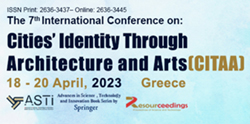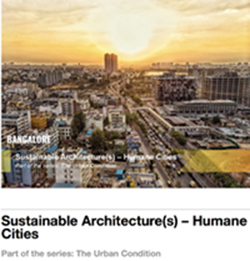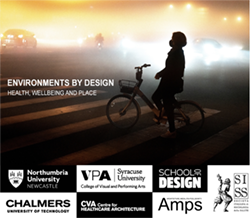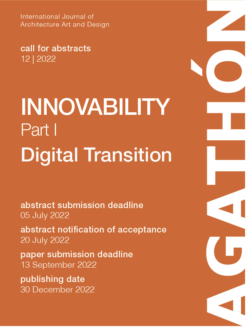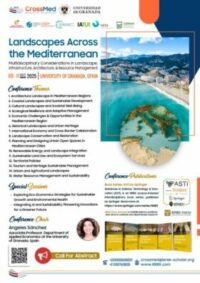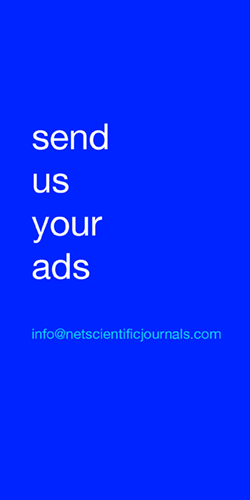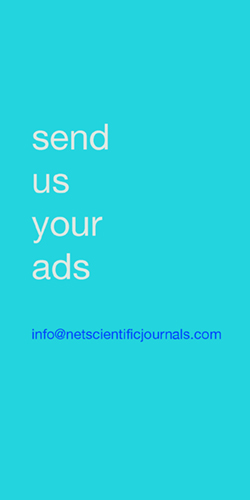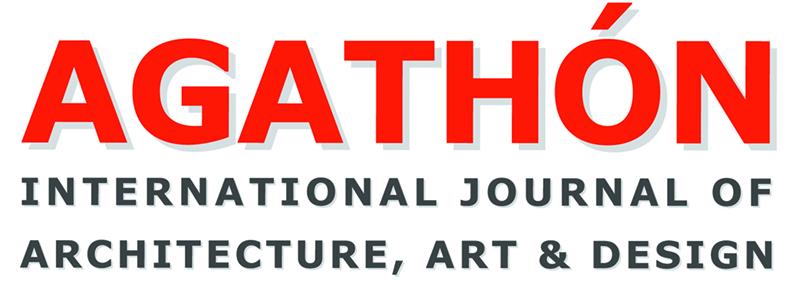ISSN (print): 2464-9309
ISSN (online): 2532-683X
Call of the Journal:
- GREENERY | Its symbiosis with the built form
- INNOVABILITY (part I) | Digital Transition
- INNOVABILITY (part II) | Ecological Transition
- INNOVABILITY (part III) | Energy Transition
- LINKS | Physical, Virtual, Digital
- MODULE | for Landscape, City, Architecture, Objects
- MODULE | for Landscape, City, Architecture, Objects
- Possible and Preferable Scenarios of a Sustainable Future | Towards 2030 and Beyond
- SDGs 1, 2, 3, 4 and 5 | Projects, research, synergies, and trade-offs
- SECOND LIFE | Regeneration, refunctionalisation, enhancement, re-cycling and up-cycling
Jul
2022
Jul
2022
Sep
2022
Oct
2022
Dec
2022
The International Scientific Committee, The International Scientific Committee, for its issue n. 11 | 2022 that will be published in December, promotes the topic Innovability (part I) | Digital Transition.
The term ‘innovability’ is used in the field of economic and social sciences. It is considered a renewed driving force for a new development paradigm that expresses one of the most crucial current challenges and the need for a ‘supportive’ convergence between the two imperative demands of ‘innovation’ and ‘sustainability’ as if they were two opposing and conflicting entities. Apart from the term used, especially during a pandemic and its economic and social impact, mankind promotes its prerogative, using ‘things’ available in nature to make other things with a primary function different from its original one (innovation), aware that those resources are not inexhaustible (sustainability). In this context, always looking to the future, we need to plan our best political and system activities to promote the need to innovate using well and consciously the resources of our planet.
‘Green and digital transitions are twin challenges’, stated Ursula von der Leyen, in her inaugural speech as President of the European Commission in 2019. In this sense, the European Green Deal, the Next Generation EU and the New European Bauhaus, together with other national Plans (for example the PNRR in Italy) have a strategic importance both in establishing, clearly and univocally, the paths of future development for an ecological, digital, cohesive and resilient Europe and in correcting the main imbalances of Europe, converging – despite the heterogeneity of the conditions of the Member States – expectations and requests, of a general nature, common and shared, of citizens and businesses. The ‘transition’ is a common thread that joins subjects and debates concerning science, technology and, at the same, time philosophy, anthropology, ecology and economy. They are described with many technical adjectives that define increasingly limited scopes, yet more open to cross-disciplinary logic, in a sort of speciation of disciplines and language recalling names such as Bateson, Commoner, Catton and Dunlap, Carpo, Kelly, Solis, Negroponte, and Jonas, Morin, Floridi, Caffo.
In this context, where digital anthropology is identified in the term ‘anticipation’, in the ability to interact with the uninterrupted flux of innovation to build a new digital ecosystem (Solis, 2016), the anthropocentric innovation finds its ideal collocation, expands and evolves, gaining the ability to put humans and their needs at the heart of new important proposals. The priority of this new form of ‘sustainable innovation’ is the social and environmental wellbeing, joint and contemporary, to facilitate an ethical and sustainable transition for the benefit of the whole community (WEF, 2022). The anthropic transformation of space is an energy-intensive practice that increases the entropy level, still really far from systematic and popular ‘cradle to cradle’ approaches or from being respectful of non-renewable resources. The subject does not concern disciplinary statutes but cross-disciplinary and cross-sectional aspects to orient and support a resilient, sustainable and inclusive ‘recovery’.
The complexity of the subject is one of the challenges of our century. On the one hand, the Global and Sustainability Initiative (GESI, 2021) shows how the ‘ecological transition’ can ethically direct the opportunities of the digital area, and The European Double Up (Accenture, 2021) affirms that the ‘digital transition’ is a useful tool to start shared projects whose implementation would otherwise be slower, less pervasive and probably less performing. On the other hand, the union between ‘green’ and ‘blue’ shows many problems and contradictions (Floridi, 2020) up to the point of thinking about the impossibility of implementing the ‘ecological transition’ together with the ‘digital transition’ (Caffo, 2021). Therefore, to make the new ‘innovability’ paradigm – with its double key of interpretation and explanation of the possible scientific research and operational approaches – reach its peak and be implemented, new (material and immaterial) tools should be presented. They should be adequate, new, transversal, interscalar and cross-disciplinary but, at the same time, it appears essential working to build and feed a bond of strategic complementarity between ecology and digital, a two-way osmosis of approaches, progresses, experiments and results within a vision of shared progress and common goals.
A little more than fifty years have passed from the Cybernetic Serendipity exposition (1968), at the Institute of Contemporary Arts of London, the digital element has become increasingly pervasive and ever-evolving, taking the role of ‘powerful enabler’, a network of connected and interconnected human and technological components (Kelly, 2010). The ‘digital transition’, according to a recent research by Deloitte, is showing itself in the improvement of production processes and in an increased use of virtuous behaviours: recycling/composting (68%), reducing energy waste and resource consumption (54%), choosing means of transport with low environmental impact (36%), focusing more on the energy efficiency of houses (36%). These conditions define new development and sustainability settings, while creating a new value, actually accompanying the ecological transition. But much needs to be done in the building industry and industrial design areas.
In the light of these considerations, AGATHÓN, turning to disciplinary areas of the Project and in particular of Landscape, Urbanism, Architecture, Engineering, Architectural Technology, Design, Restoration, Recovery, and Representation, presents the topic Innovability (part I) | Digital Transition to fuel an open dialogue, by collecting essays and critical reflections, researches and experiments, projects and actions (preferably cross-disciplinary and inter-scalar), innovative and sustainable, which address different issues, including but not limited to:
– Industry 5.0 (human-centred approach, sustainability and resilience) and digital technology as a driver for entrepreneurship, competitiveness and new professionalism;
– digital transition and project language (formal, perceptual and symbolic aspects);
– digital for ecological systems (smart ecological systems), energy (smart grids), urban (smart cities), mobility (smart mobility), building (smart buildings), housing (smart homes) and objects (smart objects);
– ICT, IoT, cloud, big data, GIS, blockchain, Artificial Intelligence, hybrid intelligence systems, machine learning and sensors for collecting and processing environmental and urban data, for resilience and risk reduction of vulnerable contexts, for designing, enjoying and managing the flexibility of spaces (internal and external), for the optimization and advanced management of the process (design, production, product, service, end of life, reuse/recycling), for non-renewable resources and scraps/waste, for improving accessibility to goods and services (leisure, well-being, health, safety, etc.), for implementing life cycles of sustainable and traceable products, for improving company, product and service performance, for the energy efficiency of the built environment and cybersecurity;
– interaction between physical and virtual spaces (virtual reality, augmented reality, ‘geotagging’, ‘location-based’ advertising, etc.);
– open-access digital platforms to share and handle data concerning the whole life cycle of the built environment (from the landscape to the small artefact);
– industrial digital platforms for modular off-site customised solutions optimised in terms of production, logistics and assembly/disassembly;
– morphogenetic, computational, parametric, generative modelling, 6D (sustainability evaluation) and 7D (operations and facility management);
– digital twin and virtual mirroring (for projects, systems and product simulations, in different life cycle stages);
– digital manufacturing to create sustainable artefacts, products and materials both on large and small scales, also through nano and biotechnologies;
– ……
INNOVABILITY (part I) | Digital Transition
The International Scientific Committee, The International Scientific Committee, for its issue n. 11 | 2022 that will be published in December, promotes the topic Innovability (part I) | Digital Transition.
The term ‘innovability’ is used in the field of economic and social sciences. It is considered a renewed driving force for a new development paradigm that expresses one of the most crucial current challenges and the need for a ‘supportive’ convergence between the two imperative demands of ‘innovation’ and ‘sustainability’ as if they were two opposing and conflicting entities. Apart from the term used, especially during a pandemic and its economic and social impact, mankind promotes its prerogative, using ‘things’ available in nature to make other things with a primary function different from its original one (innovation), aware that those resources are not inexhaustible (sustainability). In this context, always looking to the future, we need to plan our best political and system activities to promote the need to innovate using well and consciously the resources of our planet.
‘Green and digital transitions are twin challenges’, stated Ursula von der Leyen, in her inaugural speech as President of the European Commission in 2019. In this sense, the European Green Deal, the Next Generation EU and the New European Bauhaus, together with other national Plans (for example the PNRR in Italy) have a strategic importance both in establishing, clearly and univocally, the paths of future development for an ecological, digital, cohesive and resilient Europe and in correcting the main imbalances of Europe, converging – despite the heterogeneity of the conditions of the Member States – expectations and requests, of a general nature, common and shared, of citizens and businesses. The ‘transition’ is a common thread that joins subjects and debates concerning science, technology and, at the same, time philosophy, anthropology, ecology and economy. They are described with many technical adjectives that define increasingly limited scopes, yet more open to cross-disciplinary logic, in a sort of speciation of disciplines and language recalling names such as Bateson, Commoner, Catton and Dunlap, Carpo, Kelly, Solis, Negroponte, and Jonas, Morin, Floridi, Caffo.
In this context, where digital anthropology is identified in the term ‘anticipation’, in the ability to interact with the uninterrupted flux of innovation to build a new digital ecosystem (Solis, 2016), the anthropocentric innovation finds its ideal collocation, expands and evolves, gaining the ability to put humans and their needs at the heart of new important proposals. The priority of this new form of ‘sustainable innovation’ is the social and environmental wellbeing, joint and contemporary, to facilitate an ethical and sustainable transition for the benefit of the whole community (WEF, 2022). The anthropic transformation of space is an energy-intensive practice that increases the entropy level, still really far from systematic and popular ‘cradle to cradle’ approaches or from being respectful of non-renewable resources. The subject does not concern disciplinary statutes but cross-disciplinary and cross-sectional aspects to orient and support a resilient, sustainable and inclusive ‘recovery’.
The complexity of the subject is one of the challenges of our century. On the one hand, the Global and Sustainability Initiative (GESI, 2021) shows how the ‘ecological transition’ can ethically direct the opportunities of the digital area, and The European Double Up (Accenture, 2021) affirms that the ‘digital transition’ is a useful tool to start shared projects whose implementation would otherwise be slower, less pervasive and probably less performing. On the other hand, the union between ‘green’ and ‘blue’ shows many problems and contradictions (Floridi, 2020) up to the point of thinking about the impossibility of implementing the ‘ecological transition’ together with the ‘digital transition’ (Caffo, 2021). Therefore, to make the new ‘innovability’ paradigm – with its double key of interpretation and explanation of the possible scientific research and operational approaches – reach its peak and be implemented, new (material and immaterial) tools should be presented. They should be adequate, new, transversal, interscalar and cross-disciplinary but, at the same time, it appears essential working to build and feed a bond of strategic complementarity between ecology and digital, a two-way osmosis of approaches, progresses, experiments and results within a vision of shared progress and common goals.
A little more than fifty years have passed from the Cybernetic Serendipity exposition (1968), at the Institute of Contemporary Arts of London, the digital element has become increasingly pervasive and ever-evolving, taking the role of ‘powerful enabler’, a network of connected and interconnected human and technological components (Kelly, 2010). The ‘digital transition’, according to a recent research by Deloitte, is showing itself in the improvement of production processes and in an increased use of virtuous behaviours: recycling/composting (68%), reducing energy waste and resource consumption (54%), choosing means of transport with low environmental impact (36%), focusing more on the energy efficiency of houses (36%). These conditions define new development and sustainability settings, while creating a new value, actually accompanying the ecological transition. But much needs to be done in the building industry and industrial design areas.
In the light of these considerations, AGATHÓN, turning to disciplinary areas of the Project and in particular of Landscape, Urbanism, Architecture, Engineering, Architectural Technology, Design, Restoration, Recovery, and Representation, presents the topic Innovability (part I) | Digital Transition to fuel an open dialogue, by collecting essays and critical reflections, researches and experiments, projects and actions (preferably cross-disciplinary and inter-scalar), innovative and sustainable, which address different issues, including but not limited to:
– Industry 5.0 (human-centred approach, sustainability and resilience) and digital technology as a driver for entrepreneurship, competitiveness and new professionalism;
– digital transition and project language (formal, perceptual and symbolic aspects);
– digital for ecological systems (smart ecological systems), energy (smart grids), urban (smart cities), mobility (smart mobility), building (smart buildings), housing (smart homes) and objects (smart objects);
– ICT, IoT, cloud, big data, GIS, blockchain, Artificial Intelligence, hybrid intelligence systems, machine learning and sensors for collecting and processing environmental and urban data, for resilience and risk reduction of vulnerable contexts, for designing, enjoying and managing the flexibility of spaces (internal and external), for the optimization and advanced management of the process (design, production, product, service, end of life, reuse/recycling), for non-renewable resources and scraps/waste, for improving accessibility to goods and services (leisure, well-being, health, safety, etc.), for implementing life cycles of sustainable and traceable products, for improving company, product and service performance, for the energy efficiency of the built environment and cybersecurity;
– interaction between physical and virtual spaces (virtual reality, augmented reality, ‘geotagging’, ‘location-based’ advertising, etc.);
– open-access digital platforms to share and handle data concerning the whole life cycle of the built environment (from the landscape to the small artefact);
– industrial digital platforms for modular off-site customised solutions optimised in terms of production, logistics and assembly/disassembly;
– morphogenetic, computational, parametric, generative modelling, 6D (sustainability evaluation) and 7D (operations and facility management);
– digital twin and virtual mirroring (for projects, systems and product simulations, in different life cycle stages);
– digital manufacturing to create sustainable artefacts, products and materials both on large and small scales, also through nano and biotechnologies;
– ……
ANVUR, GOOGLEScholar, DOAJ, BASE, OpenAIRE, JURN, WorldCat, MIAR, ULRICHSWEB, ICI, IP Indexing, ROAD, EZB, EBSCO, ERIH PLUS, ResearchBib, OAJI. AGATHÓN is also indexed in Digital University Library in North America, South America, Europe, Asia, Australia and Africa.
The contribution for Author of a single paper is set at € 350.00. In the case of papers written by more Authors, the article publication fee will be increased by € 50.00 for each corresponding Author in addition to the first two. The fee must be paid in accordance with the directions that will be sent to the Authors at the same time as the communication of acceptance of the paper for publication. Two corresponding Authors with primary affiliations based in countries defined by the World Bank as “Lower-Middle-Income Economies” are entitled to apply for a 50% discount on the normal APC.
To encourage the publication of contributions by Authors with primary affiliation to Universities and Research Institutions in countries defined by the World Bank as ‘low-income and lower-middle-income economies’, AGATHÓN will select a maximum of two Authors to publish their contribution for free, subject to the positive outcome of the double-blind peer-review process.

